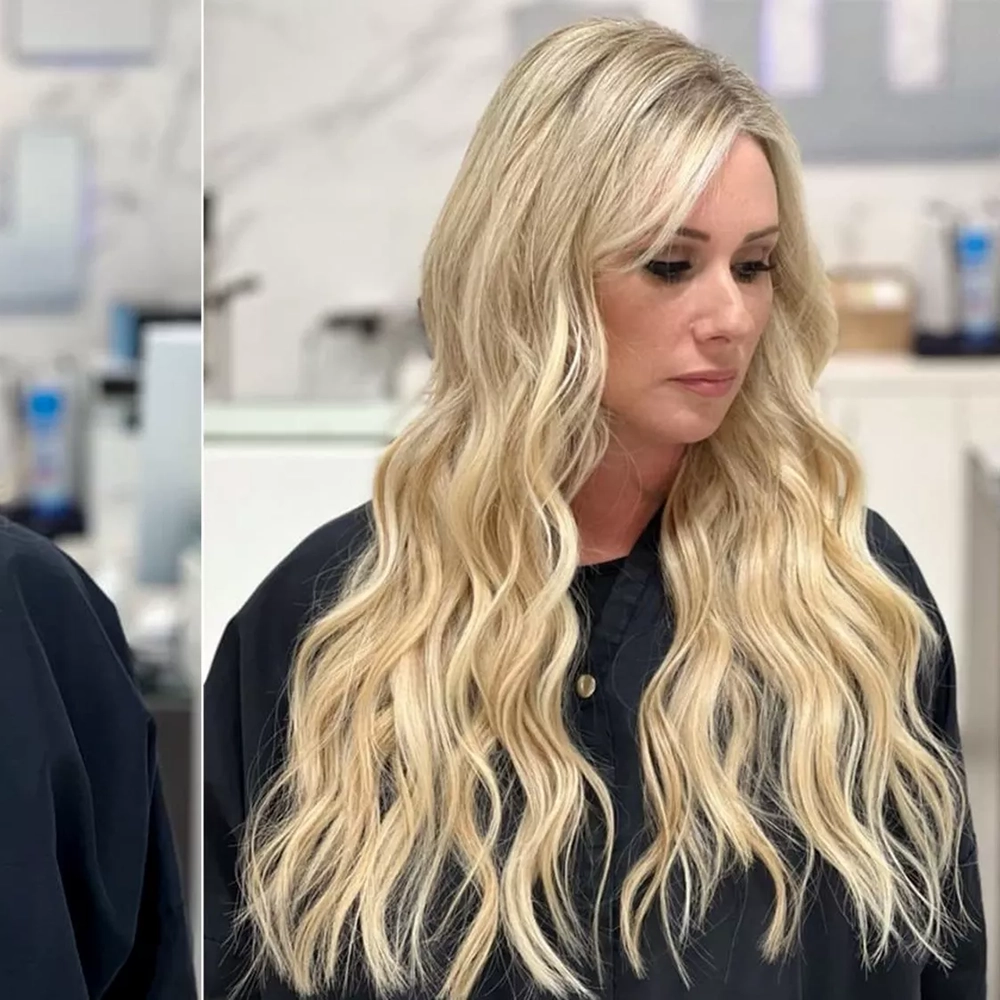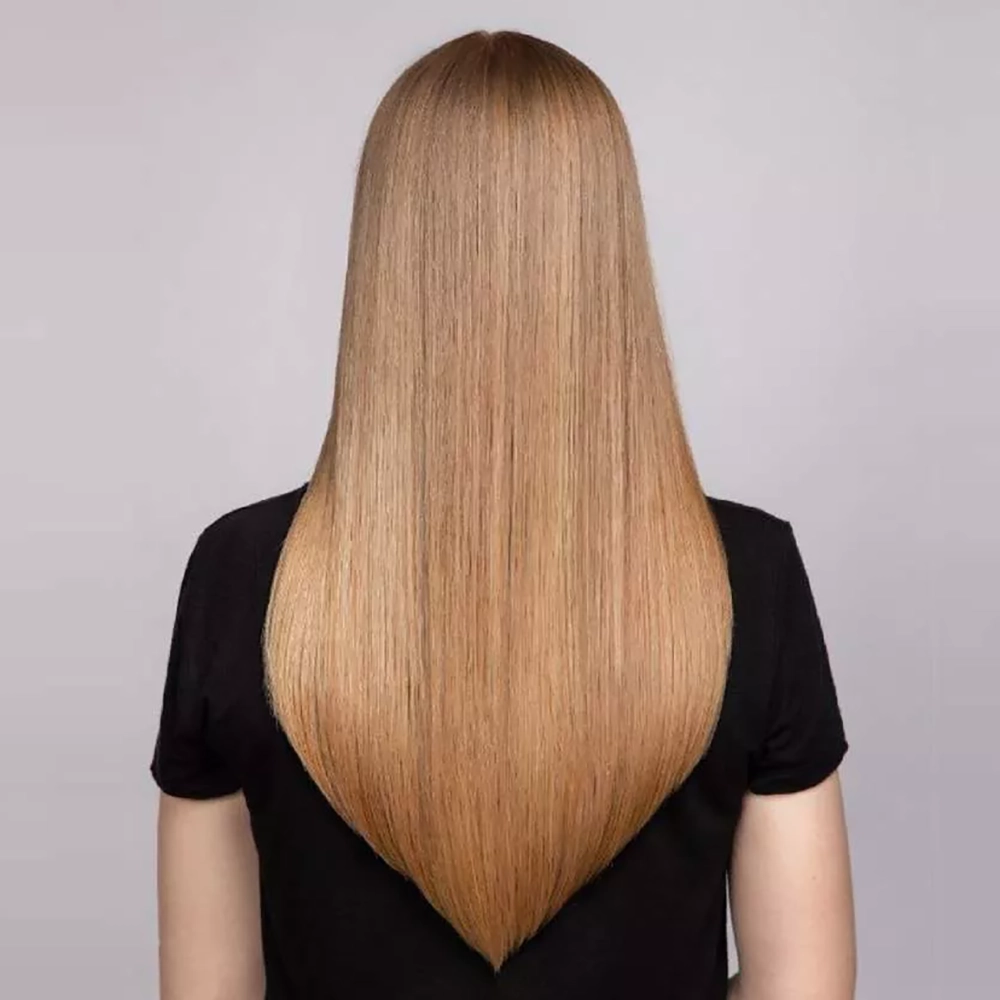Understanding Hair Extensions
When it comes to hair extensions, there are a lot of misconceptions and misunderstandings. Many people believe that hair extensions are only for adding length to one’s hair, but the truth is that they can also be used to add volume, thickness, and even create different styles. Hair extensions are essentially hairpieces that are attached to your natural hair to enhance its appearance. They can be made from a variety of materials, such as human hair, synthetic hair, or a combination of both. Understanding the different types of hair extensions and their application methods can help you make an informed decision about whether or not they are right for you.
There are several types of hair extensions to choose from, including clip-in, tape-in, sew-in, fusion, and micro-link extensions. Clip-in extensions are a temporary option that can easily be applied and removed by the individual. They are great for adding length or volume for a special occasion. Tape-in extensions are semi-permanent and are attached to your natural hair using adhesive tape. Sew-in extensions, on the other hand, are sewn into braided sections of your hair for a more secure and long-lasting attachment. Fusion extensions involve the use of heat to bond the extensions to your natural hair. Lastly, micro-link extensions use small metal rings to attach the extensions to your hair without the need for glue or heat.
Before getting hair extensions, it is important to consider factors such as your hair type, lifestyle, and budget. Some methods may work better for certain hair types, while others may require more maintenance or cost. It is also essential to consult with a professional hair extension stylist who can assess your hair and provide recommendations based on your desired look and goals. Maintaining and caring for hair extensions is crucial to ensure their longevity. This includes using proper products, brushing gently, and avoiding excessive heat or styling tools that can damage the extensions.
- Clip-in extensions are temporary and easy to apply
- Tape-in extensions are semi-permanent and use adhesive tape
- Sew-in extensions are sewn into braided sections for a secure attachment
- Fusion extensions involve heat to bond the extensions
- Micro-link extensions use small rings to attach the extensions
| Extension Method | Attachment Process | Longevity |
|---|---|---|
| Clip-in | Individual attachment | Temporary |
| Tape-in | Adhesive tape | Semi-permanent |
| Sew-in | Sewn into braided sections | Long-lasting |
| Fusion | Heat bonding | Long-lasting |
| Micro-link | Small metal rings | Semi-permanent |
Choosing the Right Hair Extension Method
When it comes to hair extensions, choosing the right method is crucial to achieving the desired look. With so many different options available, it can be overwhelming to decide which method is best for you. In this blog post, we will discuss the various hair extension methods and provide you with the information you need to make an informed decision.
1. Clip-in Extensions:
Clip-in extensions are a popular choice for those who want temporary length and volume. These extensions are attached to your natural hair using small clips, making them easy to install and remove. They are also customizable, allowing you to choose how many wefts to use and where to place them.
2. Tape-in Extensions:
Tape-in extensions are semi-permanent and offer a natural look. They are attached to your natural hair using adhesive tape. These extensions lay flat against the scalp, making them virtually undetectable. They can typically be worn for several weeks before needing to be repositioned.
3. Fusion Extensions:
Fusion extensions are one of the more permanent methods available. They are attached to your natural hair using a keratin bond and a heat tool. The bond is melted and fused with your hair, creating a secure attachment. Fusion extensions can last several months with proper care.
4. Weave Extensions:
Weave extensions, also known as sew-in extensions, are a popular choice for those with thicker hair. This method involves braiding your natural hair and then sewing the extensions onto the braids. Weave extensions can last for several weeks and provide a natural look and feel.
As you can see, there are several hair extension methods to choose from. It is important to consider factors such as the desired level of permanence, your hair type, and your lifestyle when selecting a method. Additionally, consulting with a professional stylist can help ensure that you choose the most suitable extension method for your needs. Whether you are looking for temporary length for a special occasion or a more long-term solution, there is a hair extension method that can help you achieve your desired look.
Hair Extension Options for Short Hair
When it comes to hair extensions, there are numerous options available for those with short hair. Whether you’re looking to add length, volume, or both, there is a hair extension method that can help you achieve your desired look. Understanding the different options and choosing the right one for your hair type and lifestyle is essential. In this blog post, we will explore the various hair extension options specifically designed for short hair and discuss their pros and cons.
Clip-In Hair Extensions: Clip-in hair extensions are a popular choice for individuals with short hair, as they offer a quick and easy way to add length and volume. These extensions are available in a variety of lengths, colors, and textures, making it easy to find a set that matches your natural hair. The clips attached to the wefts allow you to secure the extensions to your hair, providing a temporary solution that can be easily removed at the end of the day.
Tape-In Hair Extensions: Another option for short hair is tape-in hair extensions. These extensions involve sandwiching small sections of your natural hair between two adhesive strips, creating a seamless look. Tape-in extensions are known for their versatility, as they can be easily styled and are less damaging to the hair compared to other methods. They are also a great option for individuals with fine or thin hair, as the extensions lay flat against the scalp.
Micro-Loop Hair Extensions: Micro-loop or micro-bead hair extensions are a popular choice for those with shorter hair, as they require no glue or heat for application. These extensions involve attaching small sections of hair to tiny silicone-lined beads, which are then clamped securely in place. Micro-loop extensions offer flexibility in terms of maintenance and can be easily adjusted as your natural hair grows. However, it is important to note that improper application or removal can cause damage to the natural hair.
Conclusion: Hair extensions offer a fantastic solution for individuals with short hair who desire longer and fuller locks. Whether you opt for clip-in, tape-in, or micro-loop extensions, each method has its own advantages and considerations. It is important to consult with a professional stylist to determine the best option for your hair type and to ensure proper application and maintenance. With the right hair extension method, you can transform your short hair into the luscious locks you’ve always dreamed of.
Preparing Your Short Hair for Extensions
When it comes to achieving the long, luscious locks you’ve always dreamed of, hair extensions can be a game-changer. But if you have short hair, there are a few important steps you need to take to prepare your hair for extensions. Preparing your short hair for extensions is crucial in ensuring a seamless and natural-looking result. In this blog post, we will guide you through the necessary steps to get your short hair ready for hair extensions.
1. Assess Your Hair Length and Condition
Before diving into the world of hair extensions, it’s essential to assess your current hair length and condition. Hair extensions work best on hair that is at least a few inches long, so if your hair is shorter than that, you may need to consider other alternatives, such as clip-in extensions or hairpieces. Additionally, it’s crucial to ensure that your hair is in a healthy condition, free from excessive damage or breakage. If your hair is over-processed or fragile, it’s advisable to consult with a professional stylist before proceeding with extensions.
2. Choose the Right Extension Method
Once you’ve determined that your hair is suitable for extensions, it’s time to choose the right extension method for your short hair. The most common methods for short hair are tape-in extensions and micro link extensions. Tape-in extensions involve applying wefts of hair using adhesive tape, while micro link extensions use small rings to attach the hair strands. Both methods work well on short hair, but it’s essential to consult with a professional stylist to determine the best option for your specific needs and hair type.
3. Prepare Your Hair
Before the actual application process, you need to properly prepare your short hair. Start by washing your hair thoroughly with a clarifying shampoo to remove any product buildup or excess oils. Avoid using heavy conditioners or styling products as they can make it harder for the extensions to adhere properly. It’s also advisable to trim any split ends to ensure that your hair is as healthy as possible. Finally, make sure your hair is completely dry before moving on to the application process.
Conclusion
Preparing your short hair for extensions is a crucial step in ensuring a successful and long-lasting result. By assessing your hair length and condition, choosing the right extension method, and properly preparing your hair, you can achieve the beautiful, flowing locks you’ve always desired. Remember to consult with a professional stylist for expert guidance and to maintain your extensions properly for the best results.
The Process of Applying Hair Extensions to Short Hair
When it comes to hair extensions, there are various methods available, each suitable for different hair types and lengths. In this post, we will specifically focus on the process of applying hair extensions to short hair. Short hair can be more challenging to work with when it comes to extensions, but with the right technique and professional assistance, you can achieve a stunning and natural-looking result.
Before diving into the application process, it’s important to understand that not all hair extension methods are suitable for short hair. Some methods require a certain amount of natural hair length to be able to securely attach the extensions. Therefore, it’s crucial to consult with a hair extension specialist who can recommend the appropriate method for your specific hair length and type.
One of the most popular methods for applying hair extensions to short hair is the tape-in method. This technique involves attaching wefts of hair extensions to your natural hair using double-sided tape. The process starts with sectioning your hair and applying the tape near the roots. The hair extensions are then carefully pressed onto the tape, creating a seamless blend between your natural hair and the extensions. The tape-in method is known for its durability and natural look, making it a great option for short hair.
Tips for Maintaining Hair Extensions on Short Hair
When it comes to maintaining hair extensions on short hair, there are a few essential tips to keep in mind. Short hair can present its own unique challenges when it comes to maintaining hair extensions, but with the right care and attention, you can ensure that your extensions stay in great condition for longer. Here are some important tips to help you maintain your hair extensions on short hair:
1. Use the right products: It’s important to use hair products that are specifically designed for extensions. Look for sulfate-free shampoos and conditioners, as these will be gentle on both your natural hair and the extensions. Avoid using products that contain alcohol, as they can dry out the hair and make it more prone to damage. Additionally, using a leave-in conditioner can help keep your extensions hydrated and prevent them from becoming tangled.
2. Brush gently: When brushing your hair with extensions, be sure to use a wide-toothed comb or a brush specifically designed for extensions. Start by brushing the ends of your hair and work your way up to the roots. Avoid pulling or tugging on the extensions, as this can cause them to loosen or even break. Regular brushing helps to prevent tangling and keeps your extensions looking smooth and natural.
3. Protect while styling: Heat styling tools can be damaging to both your natural hair and extensions, so it’s important to take precautions to protect them. Before using any hot tools, apply a heat protectant spray to your hair. This will help to minimize damage and keep your extensions looking their best. Additionally, avoid using high heat settings and limit your use of styling tools to reduce the risk of damage.
By following these tips, you can maintain your hair extensions on short hair and keep them looking beautiful for longer. Remember to use the right products, brush gently, and protect your hair while styling. With proper care and attention, your extensions will seamlessly blend with your short hair and give you the length and volume you desire.
Removing Hair Extensions from Short Hair
Removing hair extensions from short hair requires careful and gentle techniques to protect your natural hair and ensure a seamless transition. Whether you have chosen tape-in, clip-in, or fusion extensions, it is important to follow the correct steps to avoid any damage or discomfort. In this blog post, we will discuss the proper methods and tips for removing hair extensions from short hair, ensuring a smooth and stress-free process.
1. Consult a Professional
Before attempting to remove your hair extensions, it is advisable to consult a professional stylist or hair extension technician. They have the expertise and experience to safely remove the extensions without causing any harm to your natural hair. A professional will also be able to suggest the most suitable products and tools for the removal process.
2. Prepare Your Hair
Prior to removing the hair extensions, it is essential to properly prepare your short hair. Gently comb through your hair to remove any tangles or knots. Applying a detangling spray or a small amount of conditioner can help make the process easier. It is crucial to be patient and take your time while detangling to avoid any unnecessary pulling or breakage.
3. Use the Correct Products
Using the right products for removing hair extensions is crucial. Look for an extension-safe adhesive remover or solution. Apply a small amount of the remover directly onto the bonds or tape, allowing it to penetrate and soften the adhesive. This will make it easier for the extensions to be gently loosened and removed without causing any damage to your natural hair.
| Extension Type | Recommended Removal Method |
|---|---|
| Tape-In Extensions | Use a hair extension adhesive remover and gently peel off the tape bonds. |
| Clip-In Extensions | Simply unclip each weft from your natural hair, starting from the bottom. |
| Fusion Extensions | Apply a specific keratin bond remover to dissolve the bonds, allowing them to slide off easily. |
4. Take It Slow
When removing extensions from short hair, patience is key. Take your time and be gentle throughout the process. Avoid pulling or tugging forcefully, as this can result in hair breakage or damage. It is recommended to remove one extension at a time, starting from the bottom and working your way up. This ensures a gradual and controlled removal process.
5. Follow Proper Aftercare
After removing the hair extensions, it is crucial to follow proper aftercare to maintain the health of your natural hair. Give your hair a break before considering reapplying any extensions. Use a nourishing conditioner and hydrating treatments to restore moisture and strength to your hair. Regular trims and deep conditioning treatments can also help prevent any damage caused by the removal process.
By following these steps and considering professional advice, you can safely remove hair extensions from your short hair. Taking the appropriate measures ensures that your natural hair remains healthy, strong, and ready for any future extensions you may choose to apply.




































